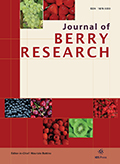Authors: Montecchiarini, M.L. | Bello, F. | Rivadeneira, M.F. | Vázquez, D. | Podestá, F.E. | Tripodi, K.E.J.
Article Type:
Research Article
Abstract:
BACKGROUND: Blueberry was introduced as a crop in Argentina about 30 years ago. Its harvesting period ranges from September to December, during the northern hemisphere (its main export destination) fall season, which makes it a profitable commercial crop. As most part of the production is exported fresh, the understanding of biochemical aspects connected with fruit firmness is crucial to improve marketable conditions. OBJECTIVE: The main purpose of this work is to explore the metabolic and physiologic changes in three highbush blueberry cultivars during maturation and the possible association with their contrasting firmness features. METHODS: Vaccinium corymbosum
…cv. ‘Emerald’, ‘Snowchaser’ and ‘O’Neal’, in order of decreasing firmness, were collected at green and ripe stages. Metabolites were analyzed by gas chromatography-mass spectrometry (GC-MS) and HPLC. Total phenolic compounds, pectin methyl esterase (PME) and β -galactosidase activities were quantified by colorimetric assays. RESULTS: Multivariate analysis of metabolites differentiated fruit regarding their maturation state in the first place. Malic, citric and phosphoric acids, asparagine (Asn) and mannitol were more abundant in green fruits. Conversely, mature fruits were distinguished by their higher content of citrulline and turanose. Other compounds were responsible for the differentiation between varieties: histidine (His), valine (Val), arginine (Arg), methionine (Met) and sucrose where high in ripe Snowchaser, while green and ripe Emerald had more tryptophane (Trp), glycine (Gly), phenylalanine (Phe), Trp, Gly and glucose. An interesting finding is that Emerald, the firmer variety, had less xylose content at both stages, possibly owing to a minor degree of cell wall degradation. Fold change of PME and β -galactosidase activity from green to ripe fruit demonstrated a divergent tendency in Emerald and Snowchaser compared to O’Neal. A correlation study strongly and positively connected firmness with citric acid and phenylalanine (Phe) content, while xylose, leucine (Leu) and shikimic acid were negatively related to this attribute. CONCLUSIONS: This study suggests that changes in the content of a few metabolite and activities of cell wall modifying enzymes during maturation period could be correlated with the observed difference in firmness of the blueberries studied. These findings may yield clues for improvements in fertilization protocols as well as to serve to the guided development of new varieties based on biochemical quality traits.
Show more
Keywords: Blueberries, metabolomic, firmness, amino acids, pectin methyl esterase (PME) β-galactosidase
DOI: 10.3233/JBR-180309
Citation: Journal of Berry Research,
vol. 8, no. 3, pp. 177-192, 2018





